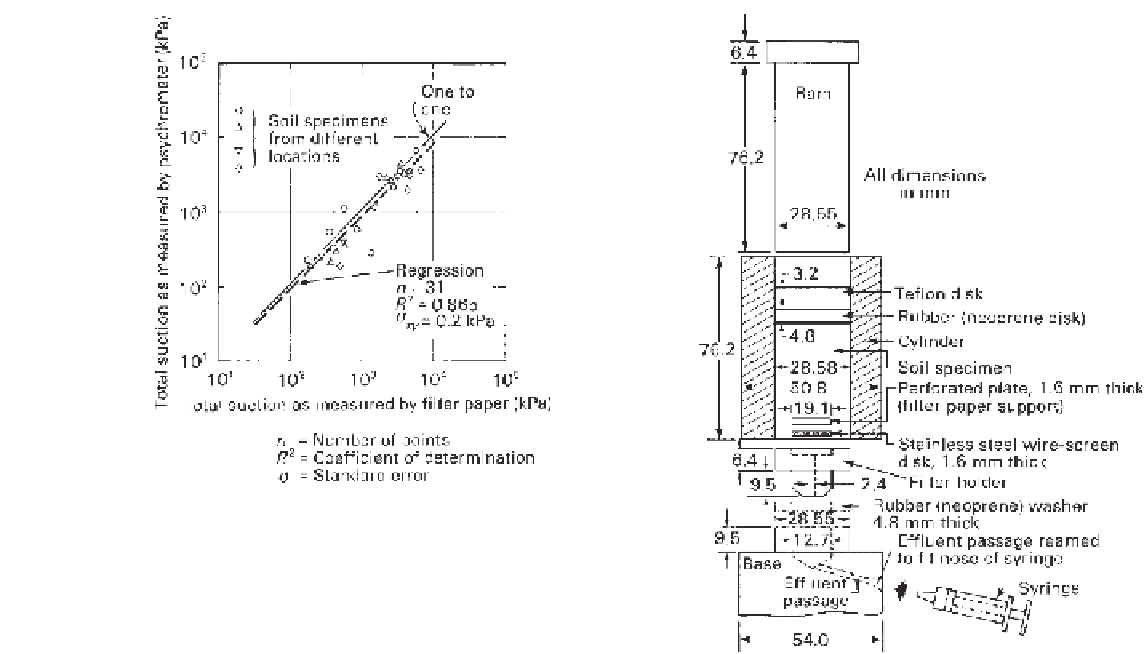Environmental Engineering Reference
In-Depth Information
Figure 4.84
Comparisons of total-suction measurements obtained
using filter paper or psychrometers (after McKeen, 1981).
It appears to be difficult to ensure adequate contact
between the soil specimen and the filter paper for the
measurement of matric suction. Consequently, total suction
is generally measured when using the filter paper method.
Figure 4.84 demonstrates reasonably close agreement
between total-suction measurements obtained when using the
filter paper method and thermocouple psychrometers.
Figure 4.85
Design of pore fluid squeezer (after Manheim, 1966).
pore-water extracted from the soil. The intent of the squeez-
ing technique is to obtain a sample of the free pore-water
which contains dissolved salts.
Pure water has a low electrical conductivity in comparison
to pore-water with dissolved salts. The electrical conductiv-
ity of the pore-water from the soil can be used to indicate
the total concentration of dissolved salts, which is related to
osmotic suction.
The pore-water in the soil can be extracted using a pore fluid
squeezer which consists of a heavy-walled cylinder and piston
squeezer (Fig. 4.85). The electrical conductivity of the pore-
water is then measured. A calibration curve (Fig. 4.86) relates
the electrical conductivity to the osmotic pressure of the soil.
The calibration relationship shown in Fig. 4.86 applies for
most salts commonly encountered in soils. The following
equation can be written to fit the line showing the relationship
between osmotic suction
π
in kilopascals, and the measured
electrical conductivity EC in millimhos per centimeter:
4.4 MEASUREMENT OF OSMOTIC SUCTION
Osmotic suction is related to the amount of salts dissolved in
the free pore-water. Several procedures can be used to mea-
sure the osmotic suction of a soil. For example, it is possible
to mix distilled water with a soil until the soil is in a near-
fluid condition and then drain off some effluent and measure
its electrical conductivity. This procedure is referred to as
the saturation extraction method. The electronic conductiv-
ity measurement then needs to be extrapolated back to the
natural water content in order to obtain the osmotic suction
for the soil. Although the test procedure is simple, there
is presently no reliable procedure for ensuring an accurate
measurement of in situ osmotic suction when using the sat-
uration extraction method (Krahn and Fredlund, 1972).
A psychrometer can also be placed over the fluid extract
to measure the vapor pressure; however, this procedure like-
wise does not produce reliable osmotic suction values. Stud-
ies have shown that the use of a pore fluid squeezer provides
the most reasonable values for osmotic suction (Krahn and
Fredlund, 1972).
0
.
024 EC
1
.
08
π
=
(4.31)
Results obtained when using the squeezing technique are
known to be somewhat affected by the magnitude of the
applied extraction pressure. Krahn and Fredlund (1972) used
an extraction pressure of 34,500 kPa when collecting fluid
for osmotic suction measurements on the glacial till and
Regina clay.
4.4.1 Squeezing Technique
The
osmotic suction
of a soil can be indirectly computed
based on the electrical conductivity of a small amount of









Search WWH ::

Custom Search